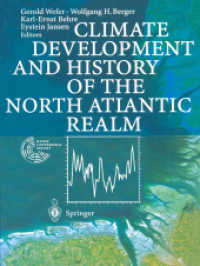- ホーム
- > 洋書
- > 英文書
- > Business / Economics
Full Description
During the second half of the 19th century, a new global market for wheat came to the fore. Ever since, scarce and perishable food has been transformed into a modern global commodity, millions of tons of which is sold, bought, and transported across the oceans, providing the "daily bread" for a fast-growing world population.
This book explores the historical origin of the global wheat market, offering an actor-centred view of the history of this new global commodity. The contributions to this volume demonstrate that the development of the global wheat trade through the late 19th and early 20th centuries has not only impacted the world food regime, it also led to the dissemination of new economic institutions. Countless technological innovations, such as elevators or telegraphic lines, have paved the way to the creation of new financial tools for trade, such as futures and grain exchanges, which transformed the market. The book also examines new global actors, such as Cargill, Louis-Dreyfus, or Bunge y Born, who took advantage of the new opportunities provided by the interlinked and globalized world grain trade. For the first time in history, the price of a single commodity which was crucial for human life ended up being decided in the areas of production by the producers and started to be fixed further afield, in specific and anonymous trading places.
The book will be of great interest to historians of economics, business, trade, agriculture, globalization, and commodities.
Contents
Introduction. Actors, places, and exchanges of the global wheat market 1. Grain merchants and famines in late Renaissance. Giovanni Maria Mersi, Tommaso Barana and the provisioning of Padua and Vicenza (1572-1616). 2. Grain Traders and the Wheat Trade in 16th and 17th century Genoa 3. Agriculture and the market: the producers' perspective (Italy, 18th cent.) 4. The Great Transition? Victualling Systems and Grain Markets in the Italian Peninsula between the 18th and 19th Centuries 5. The new "American Wheat System", Frank H. Peavey, and the "Great Western Game" 6. Finance and production in the Chicago wheat market, 1859-1914. 7. Competition among wheat exchanges. New York, Paris, London, and the global development of futures trading (1870s-1914) 8. Odessa and its wheat trade in the long 19th century, 1794-1905 9. Danzig grain trade. Economic dynamics, organisational structures and cultural challenges (1816-1914) 10. Genoa in the global wheat trade 11. Black Sea grain trade, Greek entrepreneurial networks and integration to the global economy, 19th century 12. Australia in the global wheat trade 13. The Rise and Fall of Indian Wheat in International Trade 14. Bunge & Born. The rise of a global wheat trader, 1880-1914. 15. From local to global pioneers, the Louis-Dreyfus family 16. Italy. A fringe market in a global context Index






